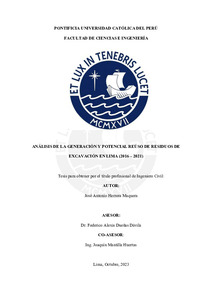| dc.contributor.advisor | Dueñas Dávila, Federico Alexis | |
| dc.contributor.author | Herrera Maquera, José Antonio | |
| dc.date.accessioned | 2024-01-24T14:05:03Z | |
| dc.date.available | 2024-01-24T14:05:03Z | |
| dc.date.created | 2023 | |
| dc.date.issued | 2024-01-24 | |
| dc.identifier.uri | http://hdl.handle.net/20.500.12404/26911 | |
| dc.description.abstract | En el Perú, unos de los pilares tanto del desarrollo del país como del sustento económico
es la industria de la construcción y es la capital donde surgen más proyectos inmobiliarios. En
consecuencia, aparece la necesidad de exponer el efecto de las actividades de la construcción
sobre el ambiente. Para el análisis se tomará el caso de la Asociación de Estudios Ecológicos e
Investigación Civil Sostenible, entidad que trabaja con los residuos limpios de excavación y
los emplea en la formación y estabilización del talud en la Costa Verde.
Como objetivo de la presente investigación se propuso un análisis estadístico de los
orígenes de los volúmenes recibidos, donde acorde al valor de los coeficientes de correlación
Pearson y Spearman de valores 0.5 y 0.8 respectivamente se determinó que la distancia entre
las obras y el punto de disposición es una variante decisiva que afecta al volumen enviado. En
adición, se realizó un pronóstico empleando el método Lineal de Holt con la data desde finales
de 2016 hasta 2021. Como resultado, el volumen a obtener en inicios del 2022 se pronosticó
de 1 053 627 m3, que representa un incremento del 25% a lo acumulado. Sin embargo, se
trabajó además un subregistro que indica un adicional 22% del volumen real recolectado hasta
la fecha que incide en el pronóstico.
Finalmente, se aplicó un análisis de ciclo de vida a la operación de reaprovechamiento.
Se determinó respecto a la categoría de cambio climático con la metodología IPCC, que 1 m3
reutilizado de material de excavación emite 20.8 kg de CO2 equivalente, 20% menos
comparado a un tratamiento regular. Asimismo, para otras categorías ambientales dentro de la
metodología ReCiPe como: agotamiento de agua, cuyo consumo se evitó en un 90% del valor
inicial; ecotoxicidad terrestre, que redujo su potencial en 50%; y en toxicidad humano no
carcinógena y eutrofización de agua dulce, se afectó en un 30%. Empleándose categorías
endpoint se calculó una reducción importante de 15% en la afectación a la salud humana y de
25% en pérdida de especies. Estos resultados resultarán de relevancia para futuros proyectos de sostenibilidad y
futuras investigaciones relacionados a la ingeniería civil y el desarrollo sostenible. | es_ES |
| dc.description.abstract | In Peru, one of the pillars of the country´s development and economic sustenance is the construction industry, and it happens that in the capital city most real estate projects arise. Consequently, there is a need to expose and demonstrate the effect of construction activities on the environment. For the case of study, it has been chosen the case of the Asociación de Estudios Ecológicos e Investigación Civil Sostenible (ADEICS), an entity that works with clean excavation waste and employs it in the formation and stabilization of the slope on the Costa Verde. As the objective of this research, a statistical analysis of the origins of the measurements received has been proposed, where according to the value of the Pearson and Spearman correlation coefficients of 0.5 and 0.8 respectively, it was determined that the distance between the construction sites and the disposal point is a critical variant that affects the volume sent. In addition, a forecast was performed using the Holt Linear Method with data from the final months of 2016 to the beginning of 2021. As a result, the volume projected at the beginning of 2022 was calculated to be 1 053 627 m3, which represents an increase of 25% over the accumulated volume. However, an under-recording was also worked out, indicating an additional 22% of the actual volume collected to date which affected the result. Finally, a Life Cycle Analysis was applied to the reuse operation. It was determined for the climate change category using IPCC methodology, that 1 m3 of reused excavated material emits 20.8 kg of CO2 equivalent, 20% less compared to a regular treatment. Likewise, for other environmental categories within the ReCiPe methodology, such as: water depletion, its consumption was reduced to a negative value of 90%; terrestrial ecotoxicity, its potential was reduced by 50%; and the human non-carcinogenic toxicity and freshwater eutrophication were affected by 30%. Using endpoint categories, a significant reduction of 15% in the impact on human health and 25% in preservation of the ecosystem was calculated. These results will be relevant for future sustainability projects and future research related to civil engineering and sustainable development. | es_ES |
| dc.language.iso | spa | es_ES |
| dc.publisher | Pontificia Universidad Católica del Perú | es_ES |
| dc.rights | info:eu-repo/semantics/openAccess | es_ES |
| dc.rights.uri | http://creativecommons.org/licenses/by/2.5/pe/ | * |
| dc.subject | Industria de la construcción--Aspectos ambientales | es_ES |
| dc.subject | Excavaciones--Reaprovechamiento | es_ES |
| dc.subject | Ciclo de vida del producto | es_ES |
| dc.title | Análisis de la generación y potencial reúso de residuos de excavación en Lima (2016 - 2021) | es_ES |
| dc.type | info:eu-repo/semantics/bachelorThesis | es_ES |
| thesis.degree.name | Ingeniero Civil | es_ES |
| thesis.degree.level | Título Profesional | es_ES |
| thesis.degree.grantor | Pontificia Universidad Católica del Perú. Facultad de Ciencias e Ingeniería | es_ES |
| thesis.degree.discipline | Ingeniería Civil | es_ES |
| renati.advisor.dni | 23860033 | |
| renati.advisor.orcid | https://orcid.org/0000-0002-6149-3334 | es_ES |
| renati.author.dni | 72916632 | |
| renati.discipline | 732016 | es_ES |
| renati.juror | Pehovaz Alvarez, Richard Paul | es_ES |
| renati.juror | Dueñas Davila, Federico Alexis | es_ES |
| renati.juror | Bartl, Karin | es_ES |
| renati.level | https://purl.org/pe-repo/renati/level#tituloProfesional | es_ES |
| renati.type | https://purl.org/pe-repo/renati/type#tesis | es_ES |
| dc.publisher.country | PE | es_ES |
| dc.subject.ocde | https://purl.org/pe-repo/ocde/ford#2.01.01 | es_ES |







